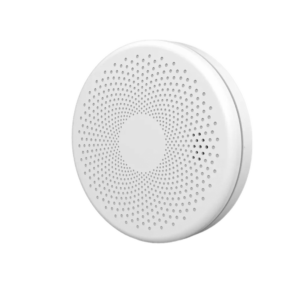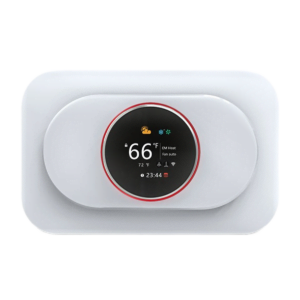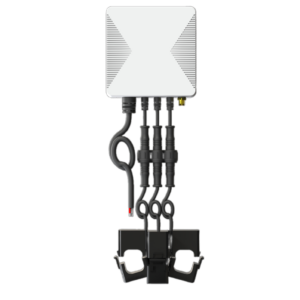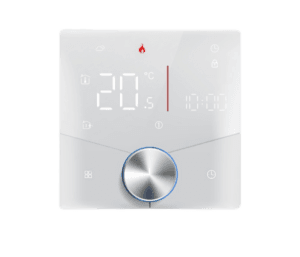Les thermostats intelligents et les thermostats de pompe à chaleur sont des outils essentiels pour réguler la température des maisons modernes. Malgré certaines similitudes, leurs fonctionnalités et leurs utilisations diffèrent considérablement. Dans cet article, nous explorerons les différences entre ces appareils, leurs principales caractéristiques et leur complémentarité pour créer un environnement domestique efficace et confortable.
Qu'est-ce qu'un thermostat intelligent ?
Athermostat intelligentIl s'agit d'un thermostat intelligent de pointe conçu pour automatiser et optimiser la température de votre maison grâce aux technologies modernes. Connecté au Wi-Fi, il permet aux utilisateurs de le contrôler à distance via une application pour smartphone ou un assistant vocal.
Principales caractéristiques des thermostats intelligents
- Connectivité Wi-Fi
- Des appareils comme leNest ThermostatorThermostat Honeywelloffrir un contrôle du chauffage et de la climatisation de la maison via une application.
- Thermostats intelligents sans filéliminer le besoin d'accès physique à l'unité.
- Efficacité énergétique
- Les thermostats intelligents analysent les habitudes de consommation pour recommander les réglages optimaux, ce qui permet d'économiser de l'énergie et de réduire les factures de services publics.
- Capteurs à distance
- Des modèles comme leThermostat SensiandThermostats avec capteurs à distanceassurer des réglages précis de la température pour chaque pièce.
- Intégration de la maison intelligente
- Compatibles avec des systèmes comme Amazon Alexa, Google Assistant et Apple HomeKit, ils en deviennent des éléments essentiels deThermostat intelligentconfigurations.
Qu'est-ce qu'un thermostat de pompe à chaleur ?
AThermostat de pompe à chaleurIl est spécialement conçu pour contrôler les pompes à chaleur, des systèmes qui assurent le chauffage et la climatisation en transférant la chaleur plutôt qu'en la produisant. Contrairement aux thermostats classiques, il est optimisé pour répondre aux besoins spécifiques des pompes à chaleur.
Caractéristiques principales des thermostats pour pompes à chaleur
- Assistance au chauffage et à la climatisation
- Les thermostats pour pompes à chaleur fonctionnent parfaitement avec les systèmes qui doivent basculer automatiquement entre les modes chauffage et refroidissement.
- Mode de chauffage d'urgence
- Ces thermostats comprennent des réglages de secours permettant d'activer le chauffage auxiliaire en cas de températures extrêmement basses, assurant ainsi un confort constant.
- Optimisé pour l'efficacité
- Themeilleur thermostat intelligent pour pompes à chaleur, comme leNest Thermostat, minimise la consommation d'énergie tout en maximisant le confort.
Thermostats intelligents vs. thermostats à pompe à chaleur
| Fonctionnalité | Thermostat intelligent | Thermostat de pompe à chaleur |
|---|---|---|
| But | Chauffage et climatisation généraux des habitations | Spécifique aux systèmes de pompe à chaleur |
| Efficacité énergétique | Optimisé pour des économies d'énergie globales | Spécialisé dans l'efficacité des pompes à chaleur |
| Connectivité | Inclut le Wi-Fi et l'intégration à la maison connectée | Peut inclure ou non des fonctionnalités intelligentes |
| Chauffage d'appoint | Non spécifiquement conçu pour le chauffage d'appoint | Prend en charge les modes de chauffage d'urgence pour les pompes à chaleur |
| Capteurs à distance | Disponible dans les modèles avancés (par exemple, thermostat avec capteurs) | Comprend rarement des capteurs à distance |
| Meilleurs modèles | Nest, Honeywell, Sensi | Nest, Ecobee, Carrier |
Comment les thermostats intelligents et les thermostats de pompe à chaleur se complètent
1.Contrôle intégré
De nombreux thermostats intelligents, tels que lesNest ThermostatorThermostat Wi-Fi HoneywellCes appareils sont compatibles avec les systèmes de pompe à chaleur. Les propriétaires peuvent ainsi profiter des fonctionnalités intelligentes de la télécommande, de la programmation et du suivi de la consommation d'énergie, tout en bénéficiant du fonctionnement efficace des pompes à chaleur.
2.Confort amélioré
Les thermostats intelligents dotés de capteurs à distance garantissent une température homogène dans toute la maison, complétant ainsi les pompes à chaleur en corrigeant les variations de chauffage ou de refroidissement.
3.Optimisation énergétique
Associés à une pompe à chaleur, les thermostats intelligents peuvent analyser les profils de consommation d'énergie afin d'optimiser les programmes de fonctionnement, maximisant ainsi l'efficacité et minimisant les coûts énergétiques.
Autres types de thermostats et leurs rôles
Robinets thermostatiques de radiateur
- Conçues pour les systèmes de chauffage à eau, ces vannes contrôlent le débit d'eau chaude vers les radiateurs, assurant ainsi des réglages de température adaptés à chaque pièce.
- Idéal pour les maisons équipées de radiateurs, mais généralement non compatible avec les pompes à chaleur.
Thermostats pour plinthes chauffantes électriques
- Ces thermostats sont spécialement conçus pour les radiateurs électriques plinthes, assurant un contrôle précis des systèmes de chauffage électrique.
- Bien qu'efficaces pour les pièces individuelles, elles ne s'intègrent pas aux systèmes centraux comme les pompes à chaleur.
Thermostats de fournaise
- Courants dans les maisons équipées de chaudières à gaz ou à fioul, ces thermostats contrôlent les systèmes de chauffage traditionnels.
- Contrairement aux thermostats de pompe à chaleur, ils ne prennent pas en charge les fonctions de refroidissement.
Thermostats de chauffe-eau
- Conçus spécifiquement pour les chauffe-eau, ces thermostats régulent la température de l'eau mais n'ont aucun rôle à jouer dans la régulation de la température ambiante.
Choisir le bon thermostat
Lors du choix d'un thermostat, tenez compte des besoins spécifiques de votre maison et de votre système de chauffage :
| Système | Thermostat recommandé |
|---|---|
| Système de pompe à chaleur | Meilleur thermostat intelligent pour pompes à chaleur (par exemple, Nest) |
| Configuration de la maison intelligente | Thermostat intelligent sans fil avec Wi-Fi (par exemple, Sensi) |
| plinthes chauffantes électriques | Thermostat pour plinthe chauffante électrique |
| Système de chauffage par radiateurs | Robinets thermostatiques de radiateur |
| Système de fournaise | Thermostat de fournaise (par exemple, Honeywell) |
Recommandations des meilleurs thermostats
1. Thermostat Nest
- Idéal pour :Intégration à la domotique et compatibilité avec les pompes à chaleur.
- Caractéristiques:Télécommande, programmation économe en énergie et compatibilité multiplateforme.
2. Thermostat Wi-Fi Honeywell
- Idéal pour :Thermostats intelligents à prix abordable.
- Caractéristiques:Connectivité Wi-Fi et contrôle simple via une application.
3. Thermostat Sensi
- Idéal pour :Installation facile et suivi de la consommation d'énergie.
- Caractéristiques:Capteurs à distance et rapports énergétiques détaillés.
4. Thermostat intelligent Ecobee
- Idéal pour :Fonctionnalités avancées et compatibilité avec de multiples systèmes.
- Caractéristiques:Alexa intégrée, capteurs à distance et compatibilité avec les pompes à chaleur.
Les thermostats intelligents et les thermostats pour pompes à chaleur jouent un rôle essentiel dans la gestion de la température des maisons modernes. Le thermostat intelligent offre connectivité, économies d'énergie et fonctionnalités avancées, tandis que le thermostat pour pompe à chaleur garantit le bon fonctionnement des systèmes de pompe à chaleur. Leur combinaison permet de créer une solution performante et intégrée pour une maison confortable et écoénergétique.
Que vous souhaitiez moderniser votre thermostat actuel ou investir dans un nouveau système de pompe à chaleur, comprendre les différences et les liens entre ces appareils vous aidera à faire le meilleur choix pour votre maison.



